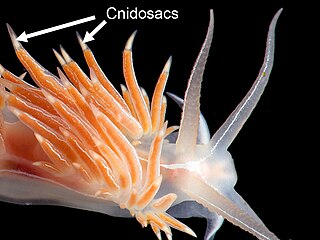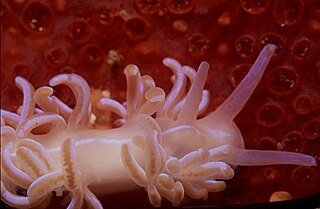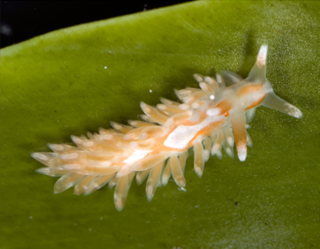
Nudibranchs are a group of soft-bodied marine gastropod molluscs that shed their shells after their larval stage. They are noted for their often extraordinary colours and striking forms, and they have been given colourful nicknames to match, such as "clown", "marigold", "splendid", "dancer", "dragon", and "sea rabbit". Currently, about 3,000 valid species of nudibranchs are known.

Cerata, singular ceras, are anatomical structures found externally in nudibranch sea slugs, especially in aeolid nudibranchs, marine opisthobranch gastropod mollusks in the clade Aeolidida. The word ceras comes from the Greek word "κέρας", meaning "horn", a reference to the shape of these structures.

Godiva quadricolor is a species of sea slug, a nudibranch, a shell-less marine gastropod mollusc in the family Facelinidae.

The purple lady nudibranch, Paraflabellina funeka, is a species of aeolid nudibranch, and is a very colourful sea slug. It is a marine gastropod mollusc in the family Flabellinidae.

The white-edged nudibranch, Coryphella capensis, previously known as Fjordia capensis, is a species of sea slug, specifically an aeolid nudibranch, a colourful sea slug. It is a marine gastropod mollusc in the family Coryphellidae.
The black-dot nudibranch, Caloria sp. 1, as designated by Gosliner, 1987, is a species of sea slug, specifically an aeolid nudibranch. They are marine gastropod molluscs in the family Facelinidae.
The yellow-tipped nudibranch, Caloria sp. 2, as designated by Gosliner, 1987, is a species of sea slug, specifically an aeolid nudibranch, a marine gastropod mollusc in the family Facelinidae.

Phyllodesmium horridum, the coral nudibranch, is a species of sea slug, specifically an aeolid nudibranch. It is a marine gastropod mollusc in the family Facelinidae.
Amanda armata, the night sky nudibranch, is a species of sea slug, specifically an aeolid nudibranch. It is a marine gastropod mollusc in the family Facelinidae.

Cratena capensis, the orange-eyed nudibranch, is a species of sea slug, specifically an aeolid nudibranch. It is a marine gastropod mollusc in the family Facelinidae.

Pteraeolidia ianthina is a sea slug, an aeolid nudibranch in the family Facelinidae. It is known as a blue dragon, a name it shares with Glaucus atlanticus and Glaucus marginatus.
Trinchesia is a genus of sea slugs, aeolid nudibranchs, marine gastropod molluscs in the family Trinchesiidae. All species were transferred to Tenellia as a result of a DNA phylogeny study in 2016. The genus was dismembered and broken into several smaller genera in 2017 with further DNA evidence and a re-interpretation of genus and family characteristics.

Coryphellina rubrolineata is a species of sea slug, an aeolid nudibranch, a marine heterobranch mollusc in the family Flabellinidae.

Orienthella trilineata, common name three-lined aeolid, is a species of sea slug, an aeolid nudibranch, a marine heterobranch mollusc in the family Flabellinidae.

Anteaeolidiella lurana, is a species of sea slug, an aeolid nudibranch. It is a marine gastropod mollusc in the family Aeolidiidae.

Tenellia phoenix is a species of sea slug, an aeolid nudibranch, a marine gastropod mollusc in the family Fionidae.
Trinchesia kuiteri is a species of sea slug, an aeolid nudibranch, a marine gastropod mollusc in the family Trinchesiidae.
Trinchesia pupillae is a species of sea slug, an aeolid nudibranch, a marine gastropod mollusc in the family Trinchesiidae.
Tenellia futairo is a species of sea slug, an aeolid nudibranch, a marine gastropod mollusc in the family Fionidae.
Catriona gymnota is a species of sea slug, an aeolid nudibranch, a marine gastropod mollusk in the family Trinchesiidae.












